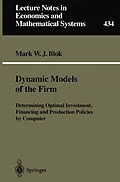1 Introduction.- 2 Mathematical Background to Dynamic Optimization.- 2.1 Introduction.- 2.2 Analytical approach to the optimization problem.- 2.2.1 Problem formulation.- 2.2.2 Solving through path coupling.- 2.3 Numerical approach to the optimization problem.- 2.3.1 Discretization.- 2.3.2 Method 1.- 2.3.3 Method 2.- 2.4 Economic interpretation of the adjoint variables.- 2.5 General procedure.- 3 The Basic Model.- 3.1 Introduction.- 3.2 The model and its assumptions.- 3.3 Examination of the paths.- 3.3.1 Introducing the adjoint variables.- 3.3.2 Determining the feasible paths.- 3.3.3 Economic interpretation of paths 4, 8 and 10.- 3.4 Case study.- 3.4.1 The case of i < (1 - f)r.- 3.4.2 The case of i > (1 - f)r.- 3.5 Conclusions.- 4 A Model with Start-up Costs.- 4.1 Introduction.- 4.2 The model and its assumptions.- 4.3 Examination of the paths.- 4.3.1 Introduction of the adjoint variables.- 4.3.2 Further examination of the stationary paths.- 4.4 Case study.- 4.4.1 The case of i < (1 - f)r.- 4.4.2 The case of i > (1 - f)r.- 4.5 Conclusions.- 5 Models with a Business Cycle.- 5.1 Introduction.- 5.2 The basic model.- 5.2.1 Description of the model.- 5.2.2 Severe recession in the case of i < (1 - f)r and m (1 - f)r and m < m°.- 5.2.5 Severe recession in the case of i > (1 - f)r and m > m°.- 5.3 A model with a variable utilization rate.- 5.3.1 Description of the model.- 5.3.2 Moderate recession in the case of i < (1 - f)r.- 5.3.3 Moderate recession in the case of i > (1 - f)r.- 5.3.4 Severe recession in the case of i > (1 - f)r.- 5.4 A model with a cash balance.- 5.4.1 Description of the model.- 5.4.2 Severe recession in the case of i < (1 - f)r and m < m*.- (1 - f)r and m < m°.- 5.4.5 Severe recession in the case of i > (1 - f)r and m > m°.- 5.5 A model with an inventory of finished goods.- 5.5.1 Description of the model.- 5.5.2 Severe recession in the case of i m*.- 5.5.3 Severe recession in the case of i > (1 - f)r and m > m°.- 5.6 Conclusions.- 6 A Model with Increasing Returns to Scale, an Experience Curve and a Production Life Cycle.- 6.1 Introduction.- 6.2 Description of the model.- 6.2.1 The production function.- 6.2.2 The price function.- 6.2.3 Problem formulation.- 6.3 Case study.- 6.4 Conclusions.- Appendices.- A Mathematical Details for Chapter 3.- A.1 Problem formulation.- A.2 Necessary conditions for optimality.- A.3 Elaborating the transversality conditions.- A.4 Further examination of some paths.- B Mathematical Details for Chapter 4.- B.1 Problem formulation.- B.2 Necessary conditions for optimality.- B.3 Elaborating the transversality conditions.- B.4 Further examination of some paths.- C Mathematical Details for Chapter 5.- C.1 The basic model.- C.1.1 Determining the coupling points for Subsection 5.2.2.- C.1.2 Determining the coupling points for Subsection 5.2.3.- C.1.3 Deriving relationships (5.22) and (5.27).- C.1.4 Determining the coupling points for Subsection 5.2.4.- C.l.5 Determining the coupling points for Subsection 5.2.5.- C.1.6 Deriving relationships (5.45) and (5.49).- C.2 A model with a variable utilization rate.- C.2.1 Necessary conditions for optimality.- C.2.2 Further examination of some paths.- C.2.3 Determining the coupling points for Subsection 5.3.2.- C.2.4 Determining the coupling points for Subsection 5.3.3.- C.2.5 Determining the coupling points for Subsection 5.3.4.- C.3 A model with a cash balance.- C.3.1 Necessary conditions for optimality.- C.3.2 Further examination of some paths.- C.3.3 Determining the coupling points for Subsection 5.4.2.- C.3.4 Determining the coupling points for Subsection 5.4.3.- C.3.5 Determining the coupling points for Subsection 5.4.5.- C.4 A model with an inventory of finished goods.- C.4.1 Necessary conditions for optimality.- C.4.2 Further examination of some paths.- C.4.3 Determining the coupling points for Subsection 5.5.2.- C.4.4 Determining the coupling points for Subsection 5.5.3.- D Mathematical Details for Chapter 6.- D.1 Necessary conditions for optimality.- Symbols and Notation.- Summary.
